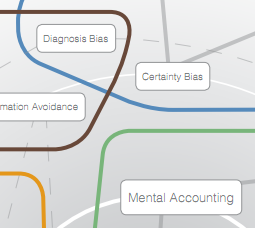Can a Maximizer be Happy with a Decision?
Friday, December 30th, 2011In cognitive design we seek to discover deeply felt and unmet psychological needs and create experiences that satisfy them. Learning to discover deeply felt psychological needs is not hard if you know where to look.
 Spend some time watching individuals or groups as they make decisions. Often the process pushes deeply felt psychological needs out into the open. For example, it is fairly easy to spot those that try to maximize a decision by searching for the best option from those that are satisficers or are happy with the first option that works.
Spend some time watching individuals or groups as they make decisions. Often the process pushes deeply felt psychological needs out into the open. For example, it is fairly easy to spot those that try to maximize a decision by searching for the best option from those that are satisficers or are happy with the first option that works.
Maximizers have a need for certainty, one that often cannot be met within the time and resource constraints of everyday life. This can leave them dissatisfied with the choices they make. After all, how can they know they really have uncovered and selected the best option? This lack of satisfaction can have many side effects. It can lead to a lack of commitment (e.g buyer’s remorse), an attempt to re-open a decision and a lot of stress.
Research at Florida State University (FSU) further reveals the psychology of maximizers:
“Because maximizers want to be certain they have made the right choice,” the authors contend, “they are less likely to fully commit to a decision.” And most likely, they are less happy in their everyday lives.”
They point out that maximizers are likely to second guess themselves even after burning a lot of mental energy in search of the best option.
This creates a serious challenge for cognitive designers. What can we do to reshape the decision experience to increase the satisfaction and commitment of maximizers with the outcome?
The FSU researchers provide some insight when it comes to consumer choice:
“Maximizers get nervous when they see an ‘All Sales Are Final’ sign because it forces them to commit,…”
 And it is not just about buying things. If you are trying to use a consensus-based decision model at work, you need the commitment of maximizers on your team.
And it is not just about buying things. If you are trying to use a consensus-based decision model at work, you need the commitment of maximizers on your team.
What can we add to the decision experience that meets the psychological needs of those that seek certainty? It won’t be certainty and admonishments to “chill out” miss the point. What can we do?










